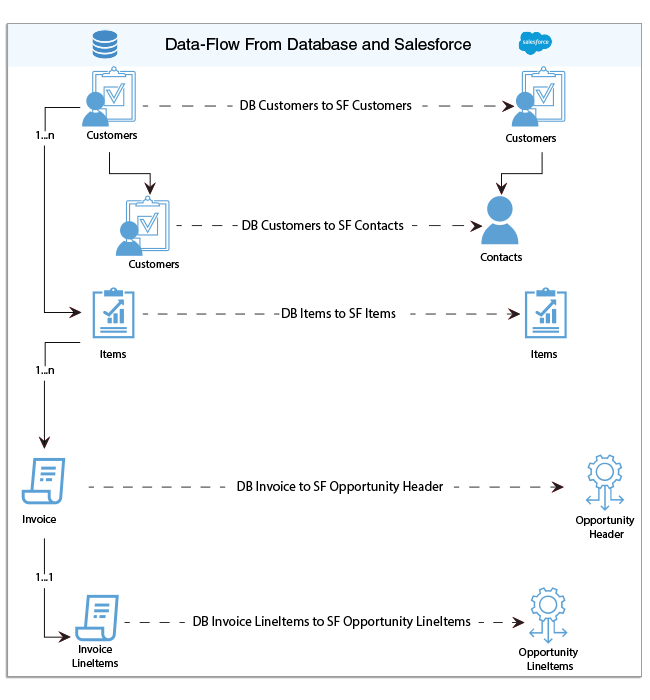2022
Overview
The DBSync for Database To Salesforce Integration is an easy to use solution to integrate Database data with Salesforce objects like accounts, contacts, products, opportunity & opportunity line items. The Database To Salesforce Integration solution is also useful to migrate historical Salesforce data into database.
Data Flow
This tutorial serves as an illustration for reading various records from Database and writing to the respective mapped objects of Salesforce . The below table depicts the data flow between various tables of Database to chosen Salesforce objects.
Process Map
The process map for Database To Salesforce solution is as shown in below image.
Prerequisites For Integration
The prerequisites for this integration are as follows
- Have valid licenses to DBSync Salesforce, Database connector and username, password to connect with DBSync iPaaS platform.
- Have your login and password of the Salesforce to access their web service.
- Setup security in Salesforce to connect through external integration.
- Should have a valid database username, password, host/IP address and port on which database is hosted.
The username and password configured for Database connector instance should have sufficient privilege to access the database which is required for integration.
Configuring Source App
The below are the steps to get started with a database and to configure the database connector.
- The below table gives the required and optional parameter to be set for establishing a connection of database and to write the various tables as chosen in the relevant workflows .
- Click on save to save the parameter settings.
| Property | Description | Required |
|---|---|---|
| Username | Database username | yes |
| Password | Database password | yes |
| Host | Host name or IP address of the database server | yes |
| Port | The port used to connect to database server | yes |
| Database | The name of your database | yes |
| Type | JDBC Driver for the Databases mentioned in the URL section in the same order.
| yes |
| Database URL | JDBC connection string
| yes |
Configuring Target App
The below are the steps to configure the DBSync's Salesforce connector
- Click on the Edit of the Salesforce connector to input the Salesforce parameters.
- Click on Save to save the settings.
The below table gives the required and optional parameter to be set for establishing a connection of Salesforce from which you would like to read the data and write to Salesforce.
Property | Description | Required |
|---|---|---|
UserName | The username to log into salesforce account. | yes |
Password | The password to login to salesforce account | Yes |
End-point | yes | |
Sid | Session Id | optional |
Transport.compression | For compression | optional |
Proxy Host | If you use a proxy server then put <<proxy ip or host>> | optional |
Proxy Port | If you use a proxy server then put <<proxy port>> | optional |
Proxy Username | If you use a proxy server then put <<proxy username>> | optional |
Proxy Password | If you use a proxy server then put <<proxy password>> | optional |
Accept Gzip | As Applicable | optional |
Send Gzip | As Applicable | optional |
For the sake of understanding, I have chosen MySQL database with tables as contacts, customers, items, oppheader, opplineitem in which data from Salesforce is dumped. You can download the sql script from this link and import the table structures in-case if you have the same integration requirement which this tutorial explains.
DBSync Project Setup
- Login into www.mydbsync.com and click on Customer Login.
- Enter your DBSync Username and Password and click on Login.
- Once logged in, Click on template library menu from the left side navigation.
- Search for template name Salesforce To Database : uni-directional template and import to your workspace.
- You will be re-directed to connector listing of the Salesforce To Database : uni-directional template
- In the connector listing page, You can see Salesforce and database connector.
- Click on Edit to configure connectors respectively and individual connector configuration are explained in the subsequent sections.
- Now, you can navigate to the process listing page to view the pre-defined mappings .
- The various transformations can be applied to the each field through the mapping section and save the workflow
- Click on the Run now button to initiate the integration of the chosen workflow.
- The sync can be monitored through the log section of the and in the event of the error, you can drill down the each event log to debug and to fix the error at its occurrence.
Run Integrations
Integration can be run using scheduler or Run Now button. Scheduler job are used to trigger process at scheduled time interval automatically while as manual trigger of the sync can be initiated by hitting the Run Now button from the process listing page / workflow page.
Scheduler
To create a scheduler job , one have to follow the below steps.
- Inside a project, Navigate to the scheduler page from the left side navigation.
- From the Add schedule section, Create a schedule job by selecting the process from the drop down, start on date , start on time, repeat frequency and save the job.
- If repeat frequency is set to no repeat then scheduled job trigger sync just only once as per scheduled date and time.
- If repeat frequency is set to either minutes, hourly, weekly then the process is scheduled to run at the repeat set frequency.
Run Now
To manually trigger the sync, one can hit the Run Now button in the following manner.
- Hitting the Run Now button from the process listing page.
- Hitting the Run Bow button from workflow listing page.
- By hitting the Run Now button from the Trigger page.

